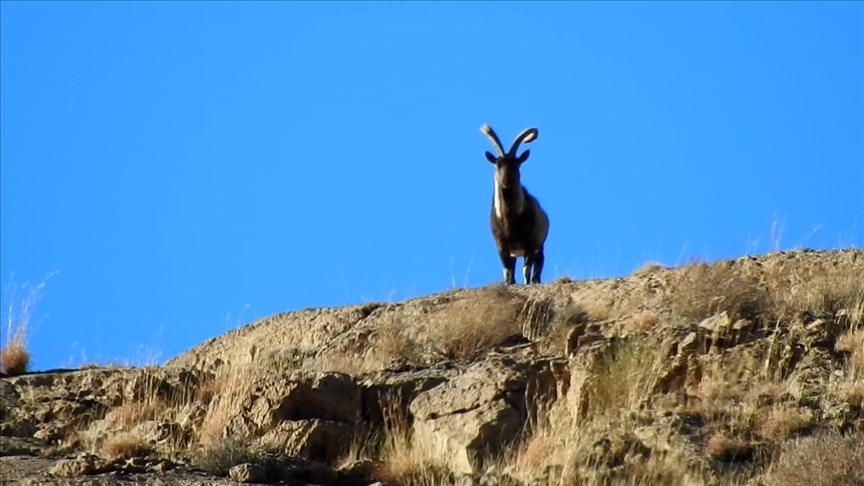Chiltan ibex: Endangered wild goat back from brink of extinction in Pakistan
In the entire world, the Chiltan ibex is only found in Pakistan’s southwestern Balochistan province

- In the entire world, the Chiltan ibex is only found in Pakistan’s southwestern Balochistan province
- Hazarganji-Chiltan National Park was established in 1980 to protect the species which was near extinction a few decades ago
- Dedicated conservation efforts supported by local communities have raised its population to around 2,250 currently from just 169 in 1975
QUETTA, Pakistan
Once reduced to just a few hundred, the population of a rare wild goat found in southwestern Pakistan has shown a gradual increase over the past five years despite the persistent threats of climate change and poaching.
Located on the western outskirts of Quetta, the capital of Balochistan province, the Hazarganji-Chiltan National Park is the only place in the world where the Chiltan ibex can be found.
Sprawling over 70,000 acres (over 28,300 hectares), the park was established in 1980 to protect the animal that was near extinction at the time, with its numbers as low as just 169 in 1975.

The range is also home to several other animals like hyenas, jackals and the Persian leopard.
With a slow and steady rise, the population of the Chiltan goat currently stands at around 2,250, according to Arz Mohammad, a conservator associated with Balochistan’s Wildlife Department.
The number was 1,600 in 2018 and 2,000 in 2021.
The current trajectory suggests that it has been increasing by 100 to 150 annually over the past five years, he said.
“This milestone has been achieved through a combination of coordinated wildlife management and the assistance of local communities, despite the lack of manpower,” Mohammad told Anadolu.
At the moment, there is a staff of 86 people for the massive park, leaving openings for illegal hunting and poaching.
“We need at least 200 people to cover such a huge area,” Mohammad added.
Climate change and increasing human intrusion
The International Union for the Conservation of Nature (IUCN) has upgraded the status of the Chiltan goat from “critically endangered” to “near-threatened,” Naseebullah, an official of the IUCN Quetta chapter told Anadolu.
Overlooked by mighty mountains, Chiltan park, until a few years ago, would offer a real safari look with minimum human intrusion.
But today, a number of concrete structures have popped up along either side of the road that passes by the park.
Experts worry that the park, one of Pakistan’s largest, could soon lose its charm to human intrusion and the greed of land-grabbers.

To make matters worse, climate change has grown to become another huge challenge over the past decade.
“Environmental variability is another challenge that we have been facing in terms of unpredictable rains and droughts,” Mohammad said.
This has badly affected the vegetation, which serves as the primary source of sustenance for animals, he added.
He, nonetheless, downplayed the threat of illegal hunting and poaching.
“There is no doubt that it is happening because of the lack of staff, but it’s not on a huge scale,” said Mohammad.
Construction near the park, he added, is only allowed in a “buffer zone,” with no encroachment in the “core zone.”
Classification controversy
Unlike in the case of the markhor and other rare animals, Chiltan park does not allow trophy hunting of the Chiltan wild goat.
Tahir Rasheed, a Quetta-based wildlife expert who was involved in drawing up the park’s first management plan launched in 1996, described the animal’s population growth as “satisfactory.”
“They (goats) were less than 300 when we launched the management plan in 1996, and now they are over 2,200,” Rasheed told Anadolu.

“Chiltan wild goat is a rare wildlife treasure for Pakistan compared to other species as it is found only in Pakistan, and only in Chiltan park,” he added.
Some wildlife experts classify the Chiltan goat as a sub-species of the markhor, Pakistan’s national animal, which Rasheed believes is not true.
“Morphological and genetic characteristics have proven that the Chiltan goat is not a kind of markhor. Rather, it’s a sub-species of the Sulaiman markhor, which is found in Balochistan,” he said.
“Its scientific name is capra aegagrus chialtanensis and it is a cross-breed of the Sulaiman markhor and ibex (Turkman wild goat).”
Another theory, Rasheed added, is that it is a cross-breed of the Sulaiman markhor and domestic goats, but said the idea does not hold any weight.
Partially endorsing the view, Mohammad, the conservator, said the morphological characters do suggest that the animal is a wild goat and not a markhor, but further research in terms of genetics is needed for proper classification.
Anadolu Agency website contains only a portion of the news stories offered to subscribers in the AA News Broadcasting System (HAS), and in summarized form. Please contact us for subscription options.







